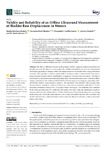Mostrar o rexistro simple do ítem
Validity and reliability of an offline ultrasound measurement of bladder base displacement in women
| dc.contributor.author | Martínez-Bustelo, Sandra | |
| dc.contributor.author | Ferri-Morales, Asunción | |
| dc.contributor.author | Castillo-García, Fernando J. | |
| dc.contributor.author | Madrid, Antonio | |
| dc.contributor.author | Jácome, M. A. | |
| dc.date.accessioned | 2022-05-04T06:35:25Z | |
| dc.date.available | 2022-05-04T06:35:25Z | |
| dc.date.issued | 2022-04-21 | |
| dc.identifier.citation | Martínez-Bustelo S, Ferri-Morales A, Castillo-García FJ, Madrid A, Jácome MA. Validity and reliability of an offline ultrasound measurement of bladder base displacement in women. J Clin Med. 2022 Apr 21;11(9):2319. | es_ES |
| dc.identifier.issn | 2077-0383 | |
| dc.identifier.uri | http://hdl.handle.net/2183/30588 | |
| dc.description.abstract | [Abstract] The effect of different exercises on the position of pelvic organs in women has not been sufficiently assessed. The objective was to analyze the validity and reliability of a new two-dimensional ultrasound algorithm to measure offline the displacement of the bladder base during abdominal exercises. This algorithm could be a useful method to future studies in determine the most appropriate exercises in sports and in rehabilitative program for the pelvic floor in women. All subjects were tested by transverse transabdominal ultrasound. The measurements were conducted offline using a customized code written in MATLAB (Ecolab) for image-processing, and manually on the ultrasound monitor using electronic calipers. The agreement was assessed with a paired t-test, Pearson’s linear correlation coefficient (r), the Lin’s concordance correlation coefficient (CCC), the intraclass correlation coefficient ICC (A,2) and a Bland–Altman plot. The reliability was confirmed by the interdays intra-rater ICC coefficient. The results were that Ecolab and ultrasound transducer measures did not differ statistically (p = 0.246). Furthermore, both methods showed a very strong relationship, and the Ecolab demonstrated to be a valid and reliable method. We concluded that Ecolab seemed to be a valid and reliable tool to assess the effect of abdominal contractions in the female pelvic floor. | es_ES |
| dc.description.sponsorship | This research was funded by COFIGA (Colegio Oficial de Fisioterapeutas de Galicia, Research Grant 2018–2019 modality B. esides, I was supported by MICINN grant PID2020-113578RB-I00, and by the Xunta de Galicia (Grupos de Referencia Competitiva ED431C-2020/14 and Centro de Investigación del Sistema Universitario de Galicia ED431G 2019/01), both of them through the ERDF | es_ES |
| dc.description.sponsorship | Xunta de Galicia; ED431C-2020/14 | es_ES |
| dc.description.sponsorship | Xunta de Galicia; ED431G 2019/01 | es_ES |
| dc.language.iso | eng | es_ES |
| dc.publisher | MDPI | es_ES |
| dc.relation | info:eu-repo/grantAgreement/AEI/Plan Estatal de Investigación Científica y Técnica y de Innovación 2017-2020/PID2020-113578RB-I00/ES/METODOS ESTADISTICOS FLEXIBLES EN CIENCIA DE DATOS PARA DATOS COMPLEJOS Y DE GRAN VOLUMEN: TEORIA Y APLICACIONES/ | |
| dc.relation.uri | https://doi.org/10.3390/jcm11092319 | es_ES |
| dc.rights | Creative Commons Attribution 4.0 International Licence (CC-BY 4.0) | es_ES |
| dc.rights.uri | http://creativecommons.org/licenses/by/4.0/ | * |
| dc.subject | Pelvic floor muscles | es_ES |
| dc.subject | Ultrasound | es_ES |
| dc.subject | MATLAB | es_ES |
| dc.subject | Validity | es_ES |
| dc.subject | Reliability | es_ES |
| dc.subject | Physiotherapy | es_ES |
| dc.title | Validity and reliability of an offline ultrasound measurement of bladder base displacement in women | es_ES |
| dc.type | info:eu-repo/semantics/article | es_ES |
| dc.rights.access | info:eu-repo/semantics/openAccess | es_ES |
| UDC.journalTitle | Journal of Clinical Medicine | es_ES |
| UDC.volume | 11 | es_ES |
| UDC.issue | 9 | es_ES |
| UDC.startPage | 2319 | es_ES |
| dc.identifier.doi | 10.3390/jcm11092319 |
Ficheiros no ítem
Este ítem aparece na(s) seguinte(s) colección(s)
-
GI-IPRF - Artigos [140]






